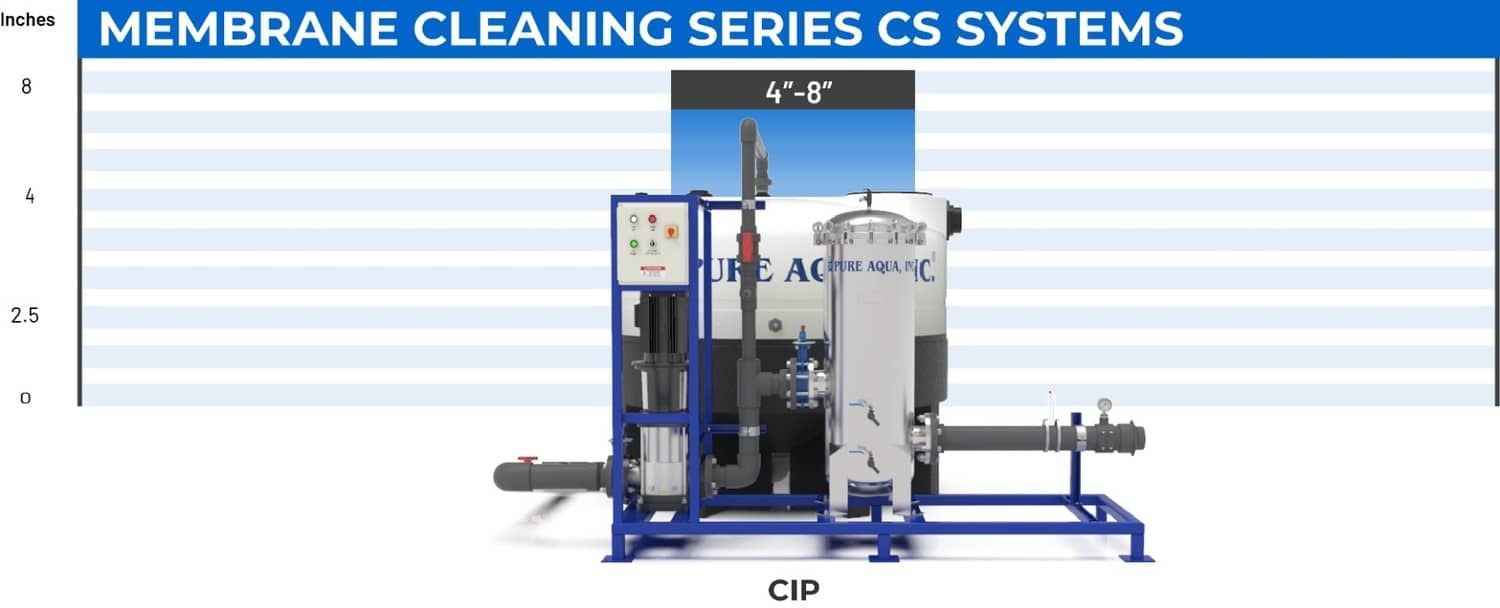Membrane Cleaning Skid Systems - CIP (Clean-In-Place)
Over a matter of time, membranes become dirty and clogged with all types of fouling occurrences such as colloidal, organic, inorganic, and biological materials creating a need for cleaning. Our membrane cleaning system cleanses the membranes and extends the lifespan by double or even triple the normal lifespan.
Fouling is the main culprit that causes membranes to stop working properly. For this reason, the following features highlight the useful ways in which membrane cleaning systems improve the performance, reliability, and durability of membrane technology. Consider the following information as important questions you will need to ask a producer before picking the correct CIP system.
Considerations of membrane cleaning systems (CIP):
- How many pressure vessels required
- Size of the pressure vessels
- Type of connection between RO and cleaning skid (permanent connection & hoses)
- Type of membrane needed to clean (RO, MF, UF, NF)
Flow Rate Range:
8 to 210 GPM
(1.8 to 48 M³/hr)
- Suitable for Cleaning: 4" or 8" Membranes
- Cleaning up to 6 vessels at a time
- Skid Mounted Systems
Pure Aqua has over 20 years of experience as a top-rated producer of high-quality membrane cleaning skid systems for any select membrane. Our engineers have progressively improved the design and performance of our membranes which has resulted in quicker recovery rates, greater efficiency in eradicating fouling, and significantly increasing membrane lifespan.
Causes of fouling:
Calcium build up, fungi, polymers, silica, sand, you name it. All manner of contaminants pass through reverse osmosis and seawater desalination systems, causing the membranes to foul or clog. With a wide range of systems for your unit size, you are guaranteed a quality membrane cleaning system. To prevent frequent cleaning, we recommend to us a genuine high quality RO chemical.
Three ways fouling can occur:
Soiling, precipitation, and absorption/adsorption. Soiling happens when colloidal particles like silica, clay and silt stick to the surface of the membrane. Precipitation takes place when the saturation level of a solution has reached its maximum. This causes the foulants to separate from the solution and bond with the surface of the membrane as they have nowhere else to go. These foulants must then be dissolved by chelating agents, which change the apparent solubility of the foulants, causing their dissolution.
Lastly absorption/adsorption occurs when biological agents are present in the solution. This includes fats, oils, proteins, greases and biological organisms which attach to the membrane and create biopolymers. Depending on the type of foulant, a special chemical or agent is needed to remove them from the membranes. Depending on the size of the unit and number of membranes, it injects the right chemicals into the system, which then clean the membranes and pressure vessels.
When to clean membranes?
When operating under normal conditions, the reverse osmosis membranes can become degraded by micropollutants, organic material, and suspended solids. These sediments accumulate during use and trigger a reduction in the output of water, salt rejection, or both. Membrane components are required to be cleaned once the standardized saturate water output lowers by at least 10% from its original flow rate, which is the flow rate recognized in the first 48 hours of use. Other instances that may indicate a need for cleaning is when the salt passage in the feed water rises by more than 10%, or when the membrane pressure drops by at least 10% as well. This is a common occurrence and demonstrates membrane fouling.
It is also important to understand that the water output rate will inevitably be reduced if the feed water temperature decreases.
What is a CIP membrane cleaning skid?
Membrane cleaning systems are designed to clean the membranes of any reverse osmosis, nanofiltration, and ultrafiltration system without dismantling them from the membrane system. As an example, CIP skids are attached to the reverse osmosis membrane array and cleansing mixtures are spread throughout the membrane components. The CIP cleaning skid usually consists of:
- Cartridge filter: eradicates organic matter discharged from the membranes
- Cleaning pump: spreads the cleansing mixture throughout the RO membranes
- Heater (optional): increases the temperature of the cleaning solution to quicken its performance
- Tank: enables blending of the cleaning solution
- Control panel: to control operating the system in auto or manual mode
- Level switch: to protect the cleaning pump from running dry
What are the features & benefits of membranes cleaning system CIP?
Our membrane cleaning chemical includes formulas that clean membranes, ensure osmosis membrane performance and enhance efficiency against fouling substances. Our RO membrane cleaning system will help you to:
- Restore the original design rates
- Extend the lifespan of the membrane
- Enhance recovery and rejection rate percentages
- Keep the membranes safe from irreparable fouling
Types of membrane cleaning systems?
Here are some of the membrane cleaning systems available to use with:
- Calcium sulfate scale
- Hardness scale
- Metallic oxide scale
- Colloidal scale
- Clay fouling
- Barium and strontium scale
- Sulfur scale
- Silica (SiO2) removal
- Silt fouling
- Iron Fouling
- Biological scale
- Organic scale
 ENGLISH
ENGLISH ESPAÑOL
ESPAÑOL العربية
العربية PORTUGUÉS
PORTUGUÉS FRANÇAIS
FRANÇAIS

